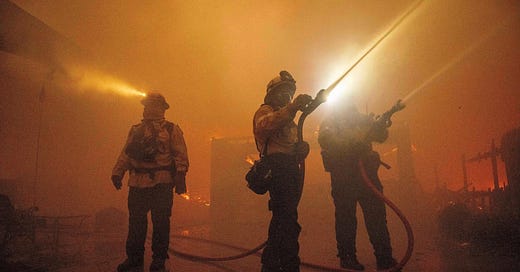Fighting Fire with Data: Optimizing Water Resource Allocation in Wildfires
How Building Real-Time Dashboards Can Enhance Wildfire Suppression Efforts
The recent (heartbreaking) wildfires in Los Angeles highlighted a critical challenge: insufficient water availability when the system is pushed to its limit. Aging infrastructure, drought conditions, and rapid urbanization have contributed to straining the city's water system, impacting the ability of firefighters to effectively combat blazes leaving thousands of homes, schools, and businesses at the mercy of the flames.
While reading through numerous articles and watching videos of firefighting crews getting to the affected areas to battle the blazes, a concerning pattern emerged: Firefighting crews often arrived at hydrants only to find them dry, suggesting a lack of knowledge regarding which hydrants had sufficient water or pressure.
We can all agree that the current infrastructure was not designed to anticipate such a large-scale catastrophe; typically, we prioritize building for "likely" scenarios, neglecting those deemed "unlikely". As LADWP CEO Janisse Quiñones said in a news conference: “We pushed the system to the extreme. Four times the normal demand was seen for 15 hours straight, which lowered our water pressure.”
While revamping the entire infrastructure is a monumental undertaking, alternative solutions could improve firefighting efficiency. One such idea I could think of is the following:
Building Real-Time Dashboards for Water Resource Optimization
This solution involves implementing a system that provides firefighters and government officials with real-time information on which hydrants have adequate pressure and water supply. This would enable firefighting departments to deploy resources strategically, avoiding the waste of time and effort associated with traveling to dry hydrants.
Real-time visual dashboards could play a crucial role in optimizing water resource allocation during wildfires. These dashboards can provide critical information such as:
Water Source Locations and Availability: Real-time updates on the status of water sources, including reservoirs, rivers, ponds, and wells, along with information on water levels, flow rates, and accessibility. These data sources should already be available, but could be integrated into this system.
Hydrant Pressure and Flow Rates: Real-time data on hydrant pressure and flow rates, enabling firefighters to identify areas with adequate water supply and prioritize their efforts accordingly.
Water Demand Forecasting: Predictive models that estimate water demand based on fire behavior, crew size, and other factors, enabling proactive planning and resource allocation. This last part could leverage technologies such as Nixtla’s forecasting models.
By leveraging real-time data, advanced analytics, and a well-designed user experience, these dashboards could empower firefighters to make more informed decisions about water resource allocation, leading to more effective and efficient wildfire suppression efforts.
I know it’s easier said than done, as there are likely a lot of technicalities involved. But while implementation may present challenges, the estimated damage and total economic loss of the Los Angeles fires of an astounding $50+ billion, underscores the need for preventive systems that enable government officials and emergency departments to respond swiftly and effectively.
I'm not a firefighting expert, but am eager to explore this topic as I'd be interested in discussing potential changes that could lead to designing a more effective and efficient firefighting system that could serve us all in the future. And if you know of someone who is already building it, please share it!


